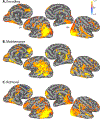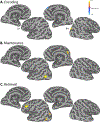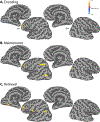Individual differences reveal limited mixed-category effects during a visual working memory task
- PMID: 30528587
- PMCID: PMC6314214
- DOI: 10.1016/j.neuropsychologia.2018.12.005
Individual differences reveal limited mixed-category effects during a visual working memory task
Abstract
Using stimuli from different categories may expand the capacity limits of working memory (WM) by spreading item representations across distinct neural populations. We explored this mixed-category benefit by correlating individuals' behavioral performance with fMRI measures of category information during uniform- and mixed-category trials. Behaviorally, we found weak evidence for a mixed-category benefit at the group-level, although there was a high degree of individual variability. To test whether distinct neural patterns elicited superior performance in some individuals, we correlated a multivariate measure of neural category information with multiple behavioral metrics. This revealed a widespread positive relationship, intuitive for hit rate and working memory capacity, but counterintuitive for false alarm rate. Overall, these data suggest that mixed-category effects may support working memory performance, but unexpectedly, not all participants show this benefit. Only some people may be able to take advantage of representing mixed-category information in a differentiable way.
Keywords: Multivariate pattern analysis; Object category; Working memory.
Copyright © 2018 Elsevier Ltd. All rights reserved.
Conflict of interest statement
Competing Interests Statement
Declarations of interest: none.
Figures






Similar articles
-
Not-so-working Memory: Drift in Functional Magnetic Resonance Imaging Pattern Representations during Maintenance Predicts Errors in a Visual Working Memory Task.J Cogn Neurosci. 2019 Oct;31(10):1520-1534. doi: 10.1162/jocn_a_01427. Epub 2019 May 21. J Cogn Neurosci. 2019. PMID: 31112474
-
Developmental changes in category-specific brain responses to numbers and letters in a working memory task.Neuroimage. 2009 Feb 15;44(4):1404-14. doi: 10.1016/j.neuroimage.2008.10.027. Epub 2008 Nov 5. Neuroimage. 2009. PMID: 19027079 Free PMC article.
-
Task alters category representations in prefrontal but not high-level visual cortex.Neuroimage. 2017 Jul 15;155:437-449. doi: 10.1016/j.neuroimage.2017.03.062. Epub 2017 Apr 4. Neuroimage. 2017. PMID: 28389381 Free PMC article.
-
From long-term to short-term: Distinct neural networks underlying semantic knowledge and its recruitment in working memory.Neuropsychologia. 2024 Sep 9;202:108949. doi: 10.1016/j.neuropsychologia.2024.108949. Epub 2024 Jul 5. Neuropsychologia. 2024. PMID: 38971371
-
Parietal-Occipital Interactions Underlying Control- and Representation-Related Processes in Working Memory for Nonspatial Visual Features.J Neurosci. 2018 May 2;38(18):4357-4366. doi: 10.1523/JNEUROSCI.2747-17.2018. Epub 2018 Apr 10. J Neurosci. 2018. PMID: 29636395 Free PMC article.
Cited by
-
Mixing and mingling in visual working memory: Inter-item competition is feature-specific during encoding and feature-general during maintenance.Atten Percept Psychophys. 2024 Aug;86(6):1846-1860. doi: 10.3758/s13414-024-02933-3. Epub 2024 Aug 12. Atten Percept Psychophys. 2024. PMID: 39134920 Free PMC article.
References
-
- Alvarez GA, & Cavanagh P (2004). The capacity of visual short-term memory is set by visual information load and by number of objects. Psychological Science, 15, 106–111. - PubMed
-
- Atkinson RC, & Shiffrin RM (1968). Human Memory: A proposed system and its control processes In Spence KW & Spence JT (Eds.), The psychology of learning and motivation (Vol. 2, pp. 89–195). New York: Academic Press.
-
- Baddeley A (1986). Working Memory.
Publication types
MeSH terms
Grants and funding
LinkOut - more resources
Full Text Sources

